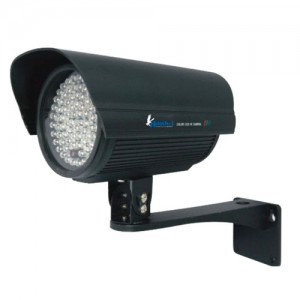 IR (InfraRed) Illuminators can shed a whole new light on digital vide recording in total darkness. Security Camera King offers several IR Illuminators in addition to the long range IR cameras for your low-light to no-light digital video security and surveillances applications.
IR (InfraRed) Illuminators can shed a whole new light on digital vide recording in total darkness. Security Camera King offers several IR Illuminators in addition to the long range IR cameras for your low-light to no-light digital video security and surveillances applications.
The average digital video security and surveillance system consists of three major components; one or more cameras, a DVR, and one or more monitors. For this article, let’s take a closer look at the digital video cameras and IR Illuminators.
A digital video camera has one main function; to transfer the image in it its field of view created by reflective light into an electronic image that can be seen on a monitor’s display. It does this by using a lens, a photosensitive sensor chip and several Integrated Circuit (IC) chips.
To be more specific the camera has something called a Field Of View for FOV. This FOV is the area that the camera sees at a given time; the lens job is to gather the light created by the FOV and focus it onto a mall 1/4 to 1/2 inch photosensitive chip.
There are two such chips used today. They are the Charged Coupled Device or CCD and the Complementary Metal Oxide Semi conductor or CMOS. Although each chip works differently, the both yield the same final product; electronic data that can be used to create a digital video image.
One very interesting note about these two sensors chips: Both chips are inherently sensitive to IR radiation of the near InfraRed spectrum. The potential for this incidental characteristic is enormous.
True day/night cameras use the available IR radiation that is present to produce their video image. They use very sensitive photo sensors. During the day time or in places where there is visible light, they utilize an IR cut filter that is mechanically moved in front of the sensor to prevent excess IR radiation from striking the sensor. These usually produce color images. Excess IR can result in poor video image quality for these sensors.
A night vision IR camera uses IR Illuminators to “light up” the images in its FOV. Most cameras use an array of IR light emitting diodes or LEDs. They produce IR “light” that the sensor readily detects but that our human eyes can’t see.
This offers a great advantage in that an area can be “flooded” with IR “light” but we would never know it because our eyes cannot see this type of light.
Generally speaking, the more LED’s the Better the IR video Image. However, due to camera size constraints, only so many IR LEDs can be packed around the camera’s lens. Therefore, if additional or stronger IR light is used, the further the camera can “see” and the better the quality of the video image. This cam be easily accomplished by using additional IR Illuminators.
There are many types of IR Illuminators. Frequently, these are used outdoors to extend the range of IR cameras, but the can be used indoors as well. Generally speaking, the more IR LEDs the longer the range and the better quality of the video.
One particularly nice benefit of using IR Illuminators is that the LEDs create adequate light at a fraction of the cost of regular, visible light yielding light bulbs. Security Camera King offers many IR cameras and IR illuminators (sold Separately) on our Web catalog. These include Product# OIL-60IR100 which has a 100 foot IR range, Product# OIL-40IR300 which has a 300 foot IR range, and Product# HAWK-4IR which has a 250 foot IR range. The first two mentioned above operate on 12VDC while the third illuminator is a dual voltage (it can use 12VDC or 24VAC)
This also is a good time to discuss range. Remember that each IR camera type has a range. The range is the distance the camera can “see” in the dark. Actually, the range is more specifically a function of the number and size of the IR LEDs used.
At any rate, always make sure you know what the IR range of a camera is before purchasing it. Measure and determine the actual footage of coverage that you will need before purchasing the illuminator. If the camera’s range falls short of your measured range, it may be time to consider purchasing an IR illuminator to extend your available range and increase the “flood” of light in your cameras FOV.
